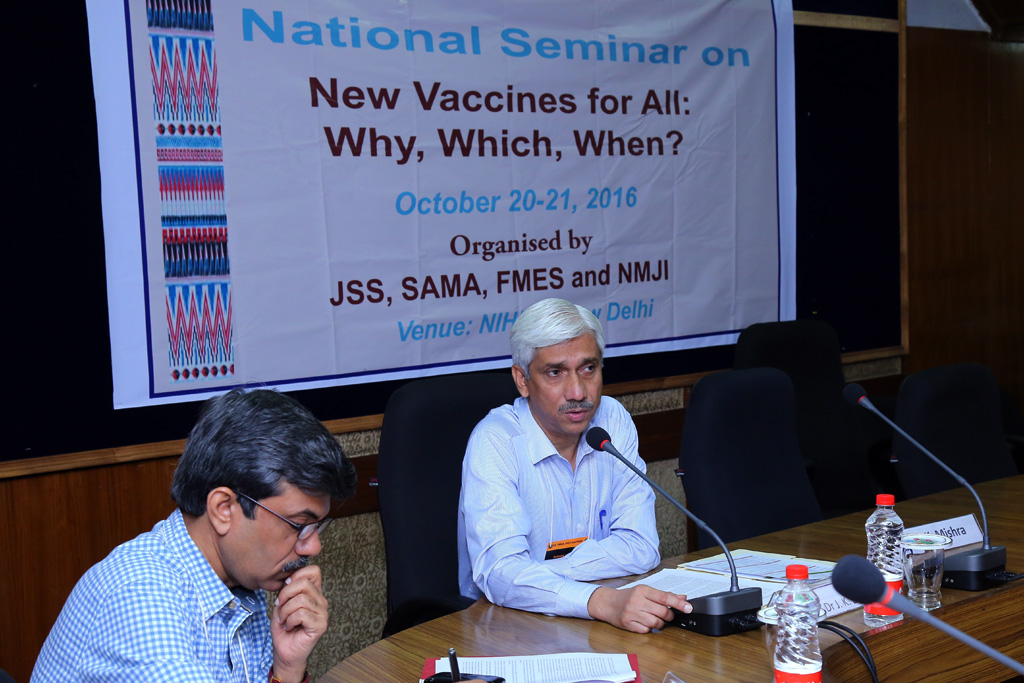
The presentations in this session were made by Dr. T. Jacob John (CMC Vellore), Dr. A. P. Dubey (MAMC) and Dr. Rakhal Gaitonde (IIT Madras).
- There is a need to critically look at the immunisation programme as more than a vaccine delivery platform. It was argued that we need a health system based on disease control strategy rather than on a vaccine delivery programme. There is a need to create a bridge between the individuals and the community, and acknowledge that healthcare (for the individual) and public health (for the community) must go hand-in-hand.
- Vaccine effectiveness and the National Immunisation Programme must aim to concentrate on the causes of the diseases that they seek to address. Further, there are two modalities – healthcare restoration which must be based on the principle of ‘fairness’ and the public health system that must addresses the ‘equity’ aspect. The national programmes in their current form do not have a goal of disease control. It lacks a good surveillance system to measure the disease control research. The government needs to allocate the requisite resources towards a robust surveillance system. There is a dearth of studies that measure disease control for childhood tuberculosis, hepatitis B Virus (HBV), Japanese Encephalitis (JE).
- It is important to stress on having a public health department in the country. The need of the hour is to accelerate the groundwork on the impact of immunisation and not just impact on diseases, in order to be able to add more new vaccines in the UIP.
- In terms of universal coverage, India lags behind in the task of achieving universal coverage of one year old children immunized against measles, according to the Coverage Evaluation Survey (CES) 2009 by UNICEF and Government of India. The CES estimated the proportion of one year old children immunized against measles was 74% in 2009. Although, this shows that there is substantial improvement in the coverage from 42% in 1992-93, yet at this rate of improvement, India was likely to achieve about 89% coverage by 2015 and thus fall short of universal coverage. There is also a rural-urban gap in this coverage – 72% in rural areas compared to 78% in urban areas. Moreover, the coverage of measles immunisation was nominally high in case of male children (74.8%) than female children (73.2%).
- While it is also important to acknowledge that certain goals in terms of immunisation coverage, like reducing infant mortality has been achieved, it is equally imperative to do an equity analysis of these targets. Need to look beyond the numerical data and do a critical analysis to include the most vulnerable who often remain excluded from our analysis. There is also a need to develop an understanding on what can be the realistic benefits from vaccination. National Policy on Vaccines (2011) focuses on vaccines alone instead of focusing on communicable disease control within which vaccines should be placed.
- There are concerns over shifting vaccine industry to the private sector while slashing the budget for the public healthcare system. It is important to underscore that the private sector has a profit motive, whereas the prerogative of public sector is to uphold the human rights concerning health of the people. The current policy does not talk about the social determinants of health, which it should.
- While it is greatly known today that access, coverage and the way human bodies produce antibodies and respond to vaccines vary according to one’s nutritional status and other social determinants.
Highlights from the Seminar Sessions
Session I: Present Status of Children’s Health and Vaccination
Session II: Prioritisation of Interventions for Disease Prevention
Session III: Inclusion of new vaccine in the UIP: How effective are new vaccines?
Session IV: Inclusion of new vaccine in the UIP: Risk assessment and safety of vaccine
Session V: Ethics and Regulations
Session VI: Inclusion of new vaccine in the UIP: Cost effectiveness and Financial issues
Session VII: Inclusion of New Vaccines in the UIP: Health System Preparedness
Recommendations
Annexures
Annexure 1: Background Note of the Seminar
Annexure 2: Seminar Schedule
Annexure 3: Organisers of the Seminar
Annexure 4: List of Participants




